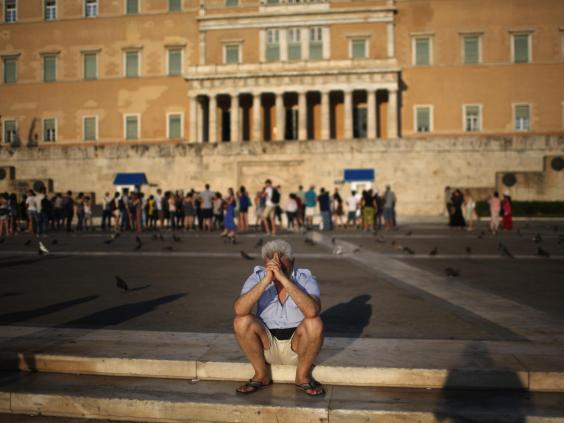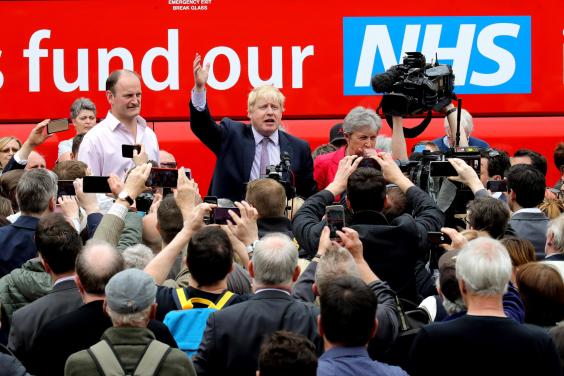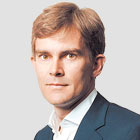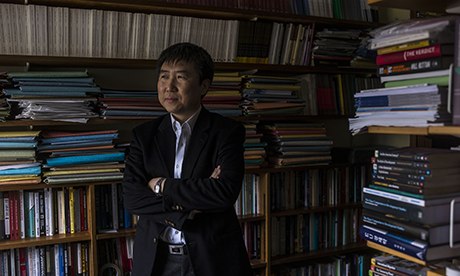By Philip Pilkington, a journalist and writer living in Dublin, Ireland
What if all the world’s inside of your head
Just creations of your own?
Your devils and your gods
All the living and the dead
And you’re really all alone?
You can live in this illusion
You can choose to believe
You keep looking but you can’t find the woods
While you’re hiding in the trees
– Nine Inch Nails,
Right Where it Belongs
Modern economics purports to be scientific. It is this that lends its
practitioners ears all over the world; from the media, from
policymakers and from the general public. Yet, at its very heart we find
concepts that, having been carried over almost directly from the
Christian tradition, are inherently theological. And these concepts
have, in a sense, become congealed into an unquestionable dogma.
We’ve all heard it before of course: isn’t neoclassical economics a religion of sorts? I’ve argued
here
in the past that neoclassical economics is indeed a sort of moral
system. But what if there are theological motifs right at the heart of
contemporary economic theory? What does this say about its validity and
what might this mean in relation to the social status of its
practitioners?
Let us turn first to one of the most unusual and oft-cited pieces of
contemporary economic doctrine: rational expectations theory.
Rational Expectations: Irrationality and an Encounter with the Godhead
Rational expectations is indeed an obscure doctrine. It essentially
holds that people operating within a market generally act in line with
the expectations of neoclassical theory. This tautology – for it is a
tautology – can be traced back to Adam Smith’s ‘invisible hand’ which we
explore in more detail later on.
But this goes beyond simple tautology. The neoclassical assumptions
are themselves especially stringent and seem to be wholly counterfactual
to any observer of human behaviour. Rational expectations theory
expects people to act, well, rationally. More specifically it assumes
that people always act in order to ‘
maximise their utility’
and that such actions result in optimal behaviours that ensure that
prices are always perfectly in keeping with what they ‘should be’ – that
is, an equilibrium price that perfectly balances supply and demand.
Prices then become a pristine and perfect measurement; they translate
consumer desire perfectly and are beyond question.
Utility maximisation is a strange doctrine that goes right to the
heart of rational expectations theory. It assumes that a fixed value can
be placed on the satisfaction people derive from the things they buy.
It also assumes – implicitly – that people are in some sense aware of
this value and that they undertake their actions rationally in
accordance with their perception of it.
At a glance this seems outlandish. Take consumption as the most
glaring example. Anyone who has ever encountered any sort of marketing
knows well that people don’t act in a perfectly rational manner. People
often consume in line with what they perceive to be group expectations.
Marketers and corporations take advantage of this and use it as leverage
to jack up prices on certain goods. For example, are my brand name
jeans really worth that much more in tangible terms than a non-brand
names pair of jeans? I would say not.
Economists might counter this by arguing that consumers are still
acting rationally insofar as their responding to marketers and brand
names helps them further their social esteem: it gives them ‘social
capital’ and it is this that the marketer is selling. To argue this is
to fundamentally misunderstand the psychology of the consumer. The
consumer may indeed identify with the group through the consumption of
the product, however this is a deeply emotive act – not one in which the
consumer cynically calculates that the product might enhance his or her
‘social capital’. It is not a rational response to the ‘social mores’
that the marketer is selling but rather an irrational response triggered
by certain stimuli.
Marketers have understood this for nearly a century. Consider the case of a Lynx ad run a few years ago during the World Cup (
here is the ad)
– note also that Lynx have been running similar ads for years (which
presumably means that this campaign has proved so effective that they
have no need to fundamentally change it).
There is a certain amount of group identification present in this ad
certainly (doesn’t every guy want to be the Don Juan who ‘scores’ all
the chicks?), but there is definitely a deeper strata operating here. I
don’t think I need to even point this out. The ad says it quite
explicitly: ‘Spray more, get more’. This means that not only will you
‘get more’ women if you use Lynx, but also that if you literally spray
on more Lynx you will literally get more women – a fantastic assertion.
Look again at the ad. Note how the guy is using an awful lot of Lynx.
Indeed, it almost appears as if more women appear as he sprays on more
of the deodorant (if one were to be terribly cynical one might read his
end reaction in the ad as a sexual climax induced by his extremely
liberal use of the deodorant). Anyone who has stood at a bar in a
nightclub next to a guy smelling extremely heavily of Lynx will not
doubt that this campaign has been at least somewhat effective.
The idea – a classic in marketing – is that not only to tie the
consumer to the brand through group identification and the promise of
sexual fulfilment, but to actually influence how the consumer uses the
product itself. This ensures that the consumer will purchase more of the
product because they will consume it faster. To claim that this
behaviour is somehow rational is to pervert the English language itself.
This behaviour is strongly irrational and those that attempt to
manipulate it know this better than perhaps anyone else.
While we won’t go too far into the argument here, these observations
can safely be transferred to most of the decisions that people make in
all of the spheres dealt with by rational expectations theory. From
direct investment to the purchase of stock to so-called inflation
expectations, all have a strongly irrational aspect that is often
manipulated by institutions for political and economic ends (the amount
of institutions attempting to manipulate inflation expectations at the
moment is quite incredible).
One example might be that of housing. During the boom years people
invested money in housing not just because they might see a profitable
return, but also because it became fashionable to own property – while
the following clip
is from a comedy show, the social observation is a sound one as far as
Irish society during the property bubble is concerned. The boom rested
not simply on the fact that it became ‘cool’ to own a house (this would
be the social identification element as identified in the above clip),
but also because being a homeowner has certain emotive overtones (having
a family, being free from one’s parents etc.). These social
expectations and emotive responses are key components not only in all
speculative bubbles, but in all so-called market activity.
The fundamental point here is that people – be they consumers or
producers, investors or forecasters – often act in an almost wholly
irrational manner; one that is quite open to manipulation. And once we
allow for this the very premise upon which rational expectations theory
rests upon falls to pieces.
This is all very interesting, but it has nothing to do with theology,
surely. Well, it is in the next key tenet of rational expectations
theory that we truly encounter the Godhead.
Rational expectations theory assumes that people always operate on a
complete amount of information. Economists call this ‘forecasting’ –
although they might call it ‘crystal-ball gazing’. They do not assume
that all consumers forecast perfectly at all time. However, they do
assume that when any forecasting errors are made they are simply
anomalies.
This paper sums it up quite nicely:
The hypothesis of rational expectations means that
economic agents forecast in such a way as to minimize forecast errors,
subject to the information and decision—making constraints that confront
them. It does not mean they make no forecast errors; it simply means
that such errors have no serial correlation, no systematic component.
The idea here is that all economic actors have access to almost
perfect knowledge of economic variables over time (prices, inflation
etc.). True the above author qualifies that such forecasting is ‘subject
to information and decision’** – which is more than many other
economists allow – but this is a smokescreen. If we assume that market
actors do not make mistakes in a given market then they must, by
default, have access to almost perfect knowledge of that market;
otherwise, to say that they don’t make mistakes is silly. If they were
to have incomplete information then they would have to act, at least to
some extent, on their gut instinct and so would, by definition, not be
acting wholly rationally.
In rational expectations theory when market actors get market
variables incorrect or act in an ‘incorrect’ manner on these variables
this error is not taken to be indicative of some underlying uncertainty
in their action, but simply an anomaly; an exception to the rule.
Economic actors are assumed to have access to near perfect information,
not just about the present but about the past and future as well.
Scratch a little deeper and you’ll find that this is an even more
incredible assertion than it first appears. Rational expectations theory
essentially assumes that consumers are omniscient beings – or at least,
when they are acting ‘normally’ they are omniscient. This is where we
encounter truly theological motifs in the edifice of neoclassical
economics.
In many theologies, God is assumed to have perfect knowledge. And in
order to gain access to this knowledge one needs only to try to build
one’s relationship to God onto a higher plateau. In rational
expectations it is assumed that individuals can indeed make mistakes –
in theological terms: they can Sin – but these mistakes are never
systemic – in theological terms: individuals are always on the way
toward Salvation. As long as the individual keeps with the ‘tenets’ of
the theory (which is presupposed), Sin is minimised and the individuals
acts in line with the being possessing perfect knowledge.
The being of perfect knowledge is here not thought of as ‘God’ per
se, but instead is given the name ‘The Market’. On a purely intellectual
level the ideas seem almost identical. Both are overarching principles
governing our lives, both are generally ‘followed’ unless perverse
deviations (Sinners) crop up and both are perfect information
processors.
We will return to this when we pick up Smith’s theory of the
‘invisible hand’ – a theory from which this all stems. For now let us
turn to the true neoclassical Godhead: the efficient markets hypothesis.
The Efficient Markets Hypothesis: The Godhead Embodied
As we shall see shortly, ‘the Market’ is and always was a strongly
theological idea. However, it is in the efficient markets hypothesis
where the Godhead is truly to be located today.
Whereas the rational expectations model of the economic actor assumes
that he or she is always in some sort of relationship with a being of
perfect knowledge, the efficient markets hypothesis points the way to
this divine being itself.
To really boil it down, the efficient markets hypothesis essentially
states that all information is always already built into markets and
hence they operate perfectly in line with how neoclassical theory would
expect them to operate (i.e. with supply and demand in perfect
equilibrium and prices reflecting this perfectly). In a way, the
efficient markets hypothesis assumes that markets are made up of the
actors we previously encountered in the rational expectations model.
Since, as we have already seen, these actors always act in a predictable
way, a conglomeration of them will process information perfectly.
The question to be asked is of the ‘chicken and egg’ variety: do
these theories begin with the rational actor and then build upon this to
form the efficient markets theory OR do these theories begin with the
assumption of an overarching arena of rationality which is called ‘the
market’ and then assume peoples’ actions based on this abstraction?
I would argue that the latter is the case. As we shall later see, if
we trace these ideas right back to their roots we find that the theory
of markets is far more primal than the theory of the rational individual
– the latter is, in many ways, derived from the former.
So what status does this give the being that we call ‘the Market’?
Well, if it is a being that is presupposed to exist while only being
seen through its effects and is given the power to direct the behaviour
of individuals, then it is surely of the theological variety. It is the
Godhead embodied.
Many commentators – including this blog’s editor Yves Smith in her book
ECONNED
– have pointed out that the efficient markets hypothesis was used by
policymakers to justify their cutting back on regulations and allowing
‘the Market’ to operate without constraint. These commentators have
pointed out that it was this policy prescription that led to the current
financial crisis.
It is also to be pointed out that these prescriptions were always
undertaken with a kind of faith. Past experiences had cast into doubt
that financial markets operated in line with the efficient markets
hypothesis and yet those who pushed for deregulation were true believers
in the hypothesis; they acted as if they were in a sort of irrational
reverie, a suspension of historical remembrance wholly driven by their
beliefs. It should not be surprising then that we find this idea to be a
very close approximation of certain religious ideas and ideals.
The idea that there might be some overarching being – whether called
‘God’ or ‘the Market’ – that is directing all our activity and through
whom we can be sure our actions are just and righteous, is a very
attractive one. Like the religious ideas of yore it can both justify our
actions when they are ethically questionable – we can assure people
that such actions are in keeping with the Market’s Divine Will – and can
assure us that the actions we undertake are reflected in and through
some higher ideal – in this case a perfectly rational being we call ‘the
Market’.
These ideals can also justify our actions after the fact when the
God, so to speak, has failed. When this occurs – as has certainly
happened today – devotees can assure the general public and their
colleagues that it was simply a glitch, perhaps a testing of our faith
and that we should never question the Market’s Will. Some of the more
extreme devotees might even suggest that we have Sinned too greatly and
that we have not followed the Market’s Will adequately enough. More
deregulation is needed otherwise we might incur further punishment from
the Divine Wrath.
Lying behind rational expectations theory and the efficient markets
hypothesis is Adam Smith’s old notion of the ‘invisible hand’ and it is
to this we now turn.
The Invisible Hand and Predestination
For by grace you have been saved
through faith, and that not of yourselves; it is the gift of God, not of
works, lest anyone should boast. For we are His workmanship, created in
Christ Jesus for good works, which God prepared beforehand that we
should walk in them – Ephesians 2:8-10
It was on this passage of the bible that the famous Protestant
theologian Martin Luther based his idea that human beings had no free
will. They were always subjects of God, bound up with Him and merely
danced to whatever tune he played. This is the essence of the Protestant
idea of Predestination. God has a plan for each and every one of us and
we are just cogs in his great harmonious machine. It is His invisible
hand that controls our actions and our destinies.
The importance of the invisible hand in the work of the first modern
economist Adam Smith is hotly debated, since he used the metaphor only
three times in his whole work and even then he used it only loosely.
However, it is thought by many – and rightly, I think – as distilling
the main thrust of his work in a single, useful phrase.
For Smith, the Market should be free to largely act autonomously. It
ironed out its own inconsistencies and operated effectively and
harmoniously. But what place did this leave for the individual?
Many today claim that Smith was the great prophet of human freedom.
Yet if his theories are read as being wholly deterministic this surely
cannot be the case. If the Market acts autonomously, unconsciously
dictating all our actions then is there really space for liberty in
classical or neoclassical economic theory? I would argue not.
The invisible hand permeates all aspects of neoclassicism. In a
seminal paper entitled ‘Situational Determinism in Economics’ the
philosopher of science Spiro Latsis shows that the whole neoclassical
research program relies on an overarching determinism which he refers to
as ‘situational determinism’. What he means by this is that, given a
certain situation that a particular individual might find him or herself
in, they will always necessarily choose one path – their behaviour will
always follows a certain given direction.
This is, of course, the invisible hand at work. The person is
directed or guided by an invisible force that leads them to undertake
one action and avoid another. This should also be recognised as one of
the fundamental aspects of rational expectations theory as outlined
above: the individual is assumed to always act in a specific way and any
other actions are thought to be ‘deviations’.
The invisible hand is truly the hidden thread tying together all
sorts of neoclassical theories – from rational expectations to the
efficient markets hypothesis. And in this it is simply a reiteration, in
quote-unquote ‘secular’ form, of an age old Protestant theological
assertion. What we get is a view of a world governed and controlled by a
mystical and invisible force that sorts everything out for us.
Everything operates without human governance, the world adheres to a set
of laws handed down by an invisible agency; everything in its right
place. This is Predestination pure and simple.
(It should be noticed that Austrian School ideologue Ludwig von Mises
recognised that the invisible hand in Smith was in fact an image of God.
He held, however, that secular reasoning led in this direction and did
not see a problem with this. One can only assert that von Mises was more
self-aware than other believers. See: note 3 on page 147 of Mises’
‘Human Action’ – an ironic title given the thrust of our present
discussion).
In modern neoclassical theory we find this structure operating mainly
through the two theoretical postulates discussed in the first and
second parts of this piece.
The efficient markets hypothesis postulates that there is an
overarching and invisible force that cannot err. This is an image of a
God controlling the world and ensuring that order emerges automatically
out of chaos. All of us individuals are then conceptualised as living
inside of this holy sphere. This leads to the assumptions of rational
expectations theory.
In rational expectations theory, individuals are taken to act in the
way assumed by neoclassical economics: that is, they rationally seek to
maximise their gain in a particular way etc. The theory allows that they
sometimes make mistakes, but these are thought of as ‘deviations’ and
are never allowed be the norm. The Market, being infallible, omnipotent
and unable to err, effectively ensures that individuals are not allowed
to make mistakes in any systematic way. To cast this in theological
language: God, being infallible, omnipotent and unable to err ensures
that individuals are not able to Sin in any systematic way. While
Sinning does take place, the overall thrust is for Man to follow the
path that God has laid out for him.
The neoclassical paradigm offers its adherents a very attractive
theology. It allows them to look at the world through a remarkably
powerful set of rose-tinted glasses. It assures them that everything is
okay – provided regulators and Sinners don’t get into positions of power
– and that order and harmony will be established by an over-arching,
quasi-external power. It gives its adherents a being that they can, in a
very real sense, worship. It gives them a moral code that they can
follow and that they can use to justify their actions, even when these
appear to an external observer as being disgusting, idiotic and
objectionable.
Dogmatism and Its Dangers
Perhaps this last point is the key one. The most dangerous
personality trait of dogmatic religious devotees is their ability to
insist that their extreme views are pure truth and that any action they
undertake, no matter how destructive and stupid, are always already
sanctioned by a higher power.
In his modernist classic ‘Ulysses’, there is a beautiful sentence in
which James Joyce sums up the hypocrisy of religious dogmatists who use
their fixed beliefs to justify actions that they might not be able to
otherwise undertake in good conscience. Speaking of Oliver Cromwell’s
brutal military campaign in Ireland in the mid-seventeenth century Joyce
writes:
What about sanctimonious Cromwell and his ironsides that
put the women and children of Drogheda to the sword with the bible text
‘God is love’ pasted round the mouth of his cannon?
What about him indeed? Such is the epitaph we might one day see on
the tombstone of that strange secular religion that is neoclassical
economics – although rather than the text ‘God is love’ pasted round the
mouth of its collective cannon, there are instead written the words
‘the Market is always right’.
** As we will soon see, the meaning of the word ‘decision’ here is
very shaky. How can a deterministic theory which claims to know how
people will act allow them to have the power to make a decision? If they
have the power to make a decision then, by default, this decision will
be uncertain and no overarching theory will be able to capture it. By
making reasonable qualifications to accompany an unreasonable theory the
above author unwittingly destroys the theory itself.






